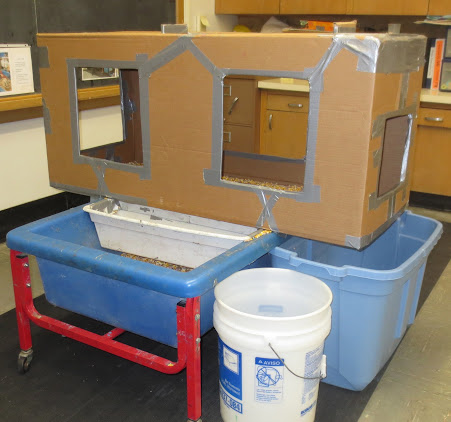Two weeks ago I began a series of posts about the three strategies I used to make changes more manageable in the sensory table so every week for the entire school year the children would experience something new there. The strategies were: 1) to keep an apparatus for a second week but change the medium in the table; 2) to keep an apparatus for a second week but add on to the existing structure; 3) to keep an apparatus for a second week but change its orientation. To read about the first strategy, here is the link To read about the second strategy, here is the link.
This week's post is all about strategy #3. As an example, I will start with an apparatus made from a big box used by moving companies to quickly pack up clothes hanging in a closet. It is called a wardrobe box. I set the box up on an incline by taping the box to a wedge contraption and the lip of the table on the low end of the box. I cut multiple holes in the box so the children had multiple entry points for their play and exploration. I cut a slit in the low end of the box so when the children poured the feed corn down the wardrobe box incline, the corn dropped into the tub at the end of the table.
They even even explored the bottom slit through which the corn exited the big box apparatus.
This apparatus had two highlights that could have been overlooked. The first was that the children pouring the corn down the box were connected in play with the children at the bottom of the box. That was all the more unique because they could not see each other since there was no hole cut out at the bottom of the box except the narrow slit where the corn exited the box. The second was that it was a total aural experience as the corn tumbled down the inclined box. It took on greater significance when a child at the end of the box knew to listen to the sound of the tumbling corn so they could get ready to catch the corn as it spewed from the box.
I wanted to use the wardrobe box a second week, but with a simple change. I removed the wedge contraption and laid the box horizontally across the width of the table.
I used planter trays to support the big box across the width of the table for extra stability. Not so unexpectedly, the planter trays offered opportunities for children to scoop in a horizontal space.
If you want to make your own comparison, you can find the original write up on the incline apparatus here and you can find the original post on the horizontal apparatus here.
Come to think of it, I did have a 4th strategy for making changes every week at the sensory table more manageable. There were several apparatus made from wood or tubes or pipes that I would save and set up from year to year. The examples I used for the three strategies were made out of cardboard. When I was done with them, I would recycle them. I knew there would always be a cardboard box when I needed to build a new apparatus. And besides, a new box would inevitably offer exciting possibilities for a completely new apparatus.








No comments:
Post a Comment